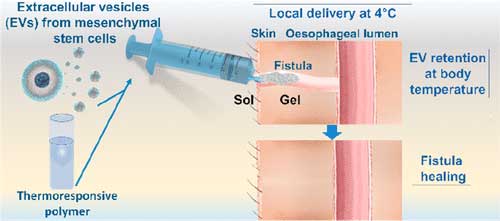| Oct 24, 2018 | |
'Cellular dust' provides new hope for regenerative medicine(Nanowerk News) While stem cells have the most therapeutic potential, the benefits of regenerative medicine may best be mobilised using extracellular vesicles (EVs), also known in the past as "cellular dust". |
|
| A team of researchers from CNRS, AP-HP, INSERM and Paris Descartes and Paris Diderot Universities have tested these vesicles for the first time in a porcine model for the treatment of post-operative digestive fistulas. | |
| Their results, which yielded a 100% success rate and appear in the 23 October 2018 edition of ACS Nano ("Thermoresponsive Gel Embedded with Adipose Stem-Cell-Derived Extracellular Vesicles Promotes Esophageal Fistula Healing in a Thermo-Actuated Delivery Strategy"), open the door to testing in humans and broader possibilities for applications. | |
 |
|
| Extracellular vesicles (EVs) are increasingly envisioned as the next generation of biological pro-regenerative nanotherapeutic agents, as has already been demonstrated for heart, kidney, liver, and brain tissues; lung injury repair; and skin regeneration. (© ACS) | |
| Extracellular vesicles are matter that is released by cells. Seen for many years as not having any value, this 'cellular dust' has been studied and presents therapeutic properties similar to their mother cells, without their disadvantages: These vesicles do not divide, limiting the risk of cancer, and do not differentiate either, thus preventing the development of poor function. | |
| Furthermore, it appears that they can be produced by a single donor for several patients, and have already demonstrated their therapeutic potential in animals in repairing heart, liver and kidney lesions. | |
| In the case of digestive fistula, in which there is abnormal communication between organs in the digestive tract or with the skin, regenerative medicine is an important therapeutic avenue to explore. Fistulas of this kind respond poorly to current treatments; they can develop following post-operative complications or an auto-immune disorders such as Crohn's disease, which causes digestive tract dysfunction. | |
| For the first time, scientists at the Matières et systèmes complexes Lab (CNRS/Université Paris Diderot), the Gastroenterology and Endoscopy Department at the Hôpital Européen Georges Pompidou (HEGP) AP-HP and the Laboratoire Imagerie de l'angiogénèse, plateforme d'imagerie du petit animal (INSERM/Université Paris Descartes/HEGP), used extracellular vesicles from stem cells to treat digestive fistula in a swine model. | |
| The study reveals that local injections into the fistula of a gel containing these vesicles results in the complete closure of post-operative digestive fistula. | |
| Researchers intend to test the new approach in a perineal fistula model found in Crohn's disease, with the hope of replacing the stem cell injections. The vesicle gel could be administered locally and easily and become a simpler, safer and more effective treatment. |
| Source: CNRS | |
|
Subscribe to a free copy of one of our daily Nanowerk Newsletter Email Digests with a compilation of all of the day's news. |
